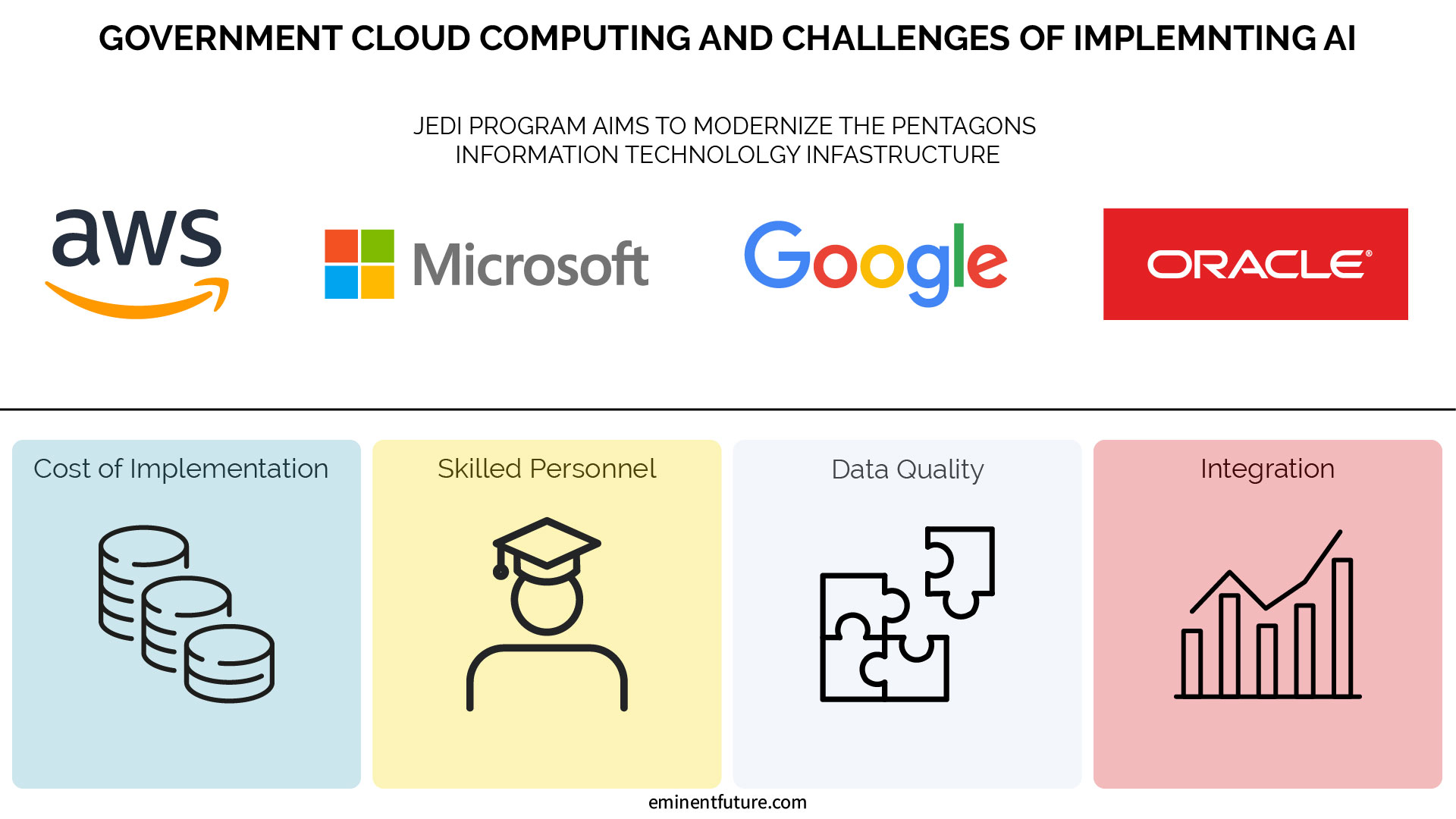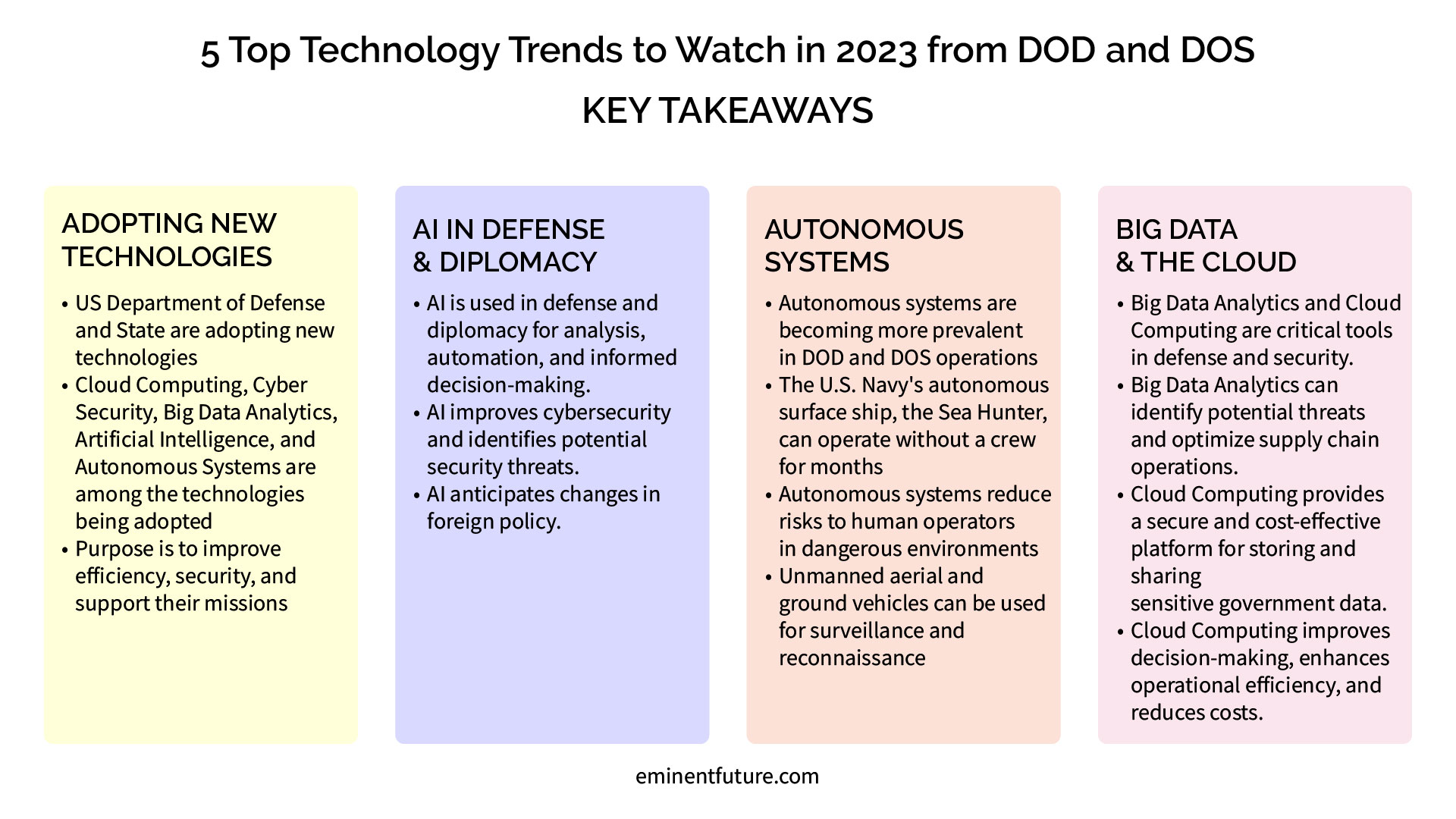The Department of Defense (DOD) and the Department of State (DOS) are two of the largest organizations in the United States federal government, responsible for securing the country’s national security and managing foreign relations and diplomacy, respectively.
As we enter 2023, these agencies are actively embracing new technologies to streamline operations, enhance security, and support their missions. In this article, we’ll explore five technology trends that will shape the DOD and DOS in the coming year: Cloud Computing, Cyber Security, Big Data Analytics, Artificial Intelligence, and Autonomous Systems.
Each of these technology trends plays a crucial role in enabling DOD and DOS to meet their objectives. Cloud Computing, for instance, enables the secure and efficient storage of vast amounts of data. Cyber Security, on the other hand, is essential for protecting against online threats, while Big Data Analytics helps to analyze data and gain insights from it.
Artificial Intelligence is being used to improve decision-making processes, and Autonomous Systems are becoming more prevalent in military and civilian applications.

Contents
- AI in Defense and Diplomacy
- The Growing Role of Autonomous Systems
- Big Data Analytics: Transforming Decision Making
- Cloud Computing Trends in the DOD and DOS
- Overcoming Implementation Challenges
- Embracing Technology for Enhanced Security and Diplomacy
AI in Defense and diplomacy

Artificial intelligence (AI) is rapidly transforming many industries, including the federal sector. The Department of Defense and the Department of State are no exception.
Both agencies are investing in AI to enhance their capabilities and stay ahead of potential threats. AI can help the agencies process vast amounts of data, automate tasks, and make more informed decisions. In the coming years, we can expect to see AI play an even greater role in defense and diplomacy.
One way the DOD is using AI is to improve cybersecurity. With the increasing sophistication of cyber threats, the DOD is leveraging AI to detect and respond to threats more quickly and effectively.
AI can help the DOD identify patterns in data that could indicate a cyber-attack is underway, allowing the agency to take proactive measures to mitigate the threat. Similarly, the DOS is using AI to analyze social media and other sources of information to identify potential security threats and anticipate changes in foreign policy. By leveraging AI, both agencies are better able to protect national security and advance U.S. interests around the world.
the growing role of autonomous systems

Autonomous systems are becoming increasingly prevalent in DOD and DOS. These systems can operate independently, without direct human control, and are being developed for a wide range of applications, from logistics to reconnaissance.
One example is the U.S. Navy’s largest autonomous surface ship, the Sea Hunter, which can operate for months without a crew and is designed for a variety of missions, including tracking submarines and detecting mines.
Autonomous systems like this can help the DOD and DOS save time and resources, while also reducing the risks associated with human operators in dangerous environments.
In addition to the Sea Hunter, the DOD, and DOS are exploring other autonomous systems, such as unmanned aerial vehicles (UAVs) and ground vehicles. These systems can be used for surveillance, reconnaissance, and other tasks, allowing the agencies to gather critical information without putting human operators at risk.
Autonomous systems can also be used to transport supplies and equipment, reducing the logistical burden on human operators, and freeing them up for other tasks. As autonomous technology continues to evolve, we can expect to see these systems play an even greater role in defense and diplomacy.
Big Data Analytics: Transforming Decision Making

Big data analytics has emerged as a critical tool in the field of defense and security. The US Department of Defense and the Department of State are increasingly relying on big data analytics to improve decision-making and gain deeper insights into various aspects of defense and security.
For instance, big data analytics can be used to analyze massive amounts of data collected from various sources such as sensors, surveillance systems, and social media, to identify patterns and trends that could help detect potential threats before they occur.
The DOD and DOS are also leveraging big data analytics to optimize their supply chain operations. With the increasing complexity of supply chain networks, big data analytics can help identify inefficiencies, bottlenecks, and areas for improvement.
This, in turn, can help reduce costs, increase efficiency, and improve responsiveness. Moreover, big data analytics can be used to enhance the visibility of the supply chain, allowing the DOD and DOS to have a real-time view of the entire supply chain network and make informed decisions based on data insights.
Cloud Computing Trends in the DOD and DOS

In addition to the Pentagon, the US Department of State is also leveraging cloud computing to improve its global operations. The department uses cloud-based systems to store and manage its critical data, such as visa applications and diplomatic cables, while also ensuring that data is accessible to its employees worldwide.
By using cloud computing, the Department of State can quickly deploy new applications, scale its operations as needed, and ensure that its data is secure from cyber threats. The use of cloud computing by both the DOS and DOD is expected to continue to grow as they seek to modernize their infrastructure and improve their operational efficiency.
Overcoming Implementation Challenges
Artificial intelligence and machine learning technologies have a lot of potential for revolutionizing various industries and improving the efficiency of different processes. However, implementing these technologies is not always an easy task. There are several challenges associated with the implementation of AI and machine learning that businesses and organizations need to consider.
One of the main challenges is the cost of implementation. AI and machine learning technologies can be quite expensive, especially for small businesses. Implementing these technologies requires significant investment in hardware, software, and infrastructure, as well as ongoing maintenance and updates. This can be a barrier for many organizations that may not have the resources to invest in such technology.
Another challenge is the lack of skilled personnel. AI and machine learning technologies require specialized skills and knowledge to implement and operate effectively. Organizations need to have access to trained professionals who can handle the complexities of these technologies. However, the demand for such personnel is high, and there is currently a shortage of skilled AI and machine learning professionals in the job market.
Data quality is also a significant challenge when it comes to implementing AI and machine learning technologies. These technologies rely on large volumes of high-quality data to function effectively. However, many organizations do not have access to the necessary data or do not have the means to collect and store it properly. Ensuring that the data used for AI and machine learning is accurate, complete, and consistent is crucial for the success of these technologies.
Finally, there is the challenge of integrating AI and machine learning technologies into existing systems and processes. Organizations may have established systems and processes that do not align with the implementation of these technologies. Implementing AI and machine learning may require significant changes to existing systems and processes, which can be difficult and time-consuming.

Embracing Technology for Enhanced Security and Diplomacy
The DOD and DOS are actively embracing new technologies to streamline operations, enhance security, and support their missions. They are investing in AI to improve cybersecurity, using autonomous systems for a wide range of applications, leveraging big data analytics to improve decision-making, and relying on cloud computing to improve their efficiency and security.
These technology trends are playing a crucial role in enabling the DOD and DOS to meet their objectives, protect national security, and advance US interests around the world. As technology continues to evolve, we can expect to see these agencies continue to push the boundaries of innovation and embrace new solutions to overcome new challenges.
Key takeaways




